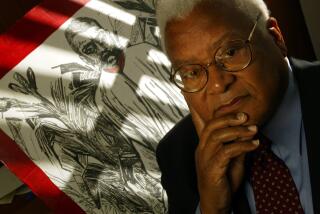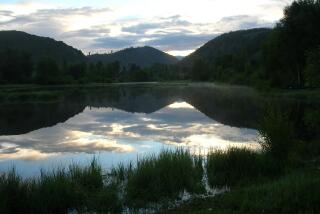Methodists Return Again to Woods Settled by Ancestors 150 Years Ago
- Share via
SHILOH, Miss. — Each year they come with their Bibles and bedding, cooking utensils and Methodist hymnals, food for the body and sustenance for the soul.
As they gather in late summer for the Shiloh Camp Meeting, a throwback to the days of Methodist circuit-riding preachers, someone is sure to tell the story of how it began more than 150 years ago.
Here in the piney woods of south-central Mississippi, church history relates, a wagon train stopped at a cool spring, a needed rest for the wandering Protestant pioneers and their oxen and slaves. The journey along wilderness trails out of the backcountry of South Carolina had been arduous and the prairie of Texas was still a long way off.
During the pause at the spring, the story goes, a young girl whose name has been lost wandered into the woods to play. Swinging on a grapevine, she fell and broke her neck.
Delayed by a day for a proper Christian burial, which was watched from a distance by a group of curious Choctaw Indians, several of the families decided that these gentle, wooded hills offered as good a place as any to start a new life.
The year was 1828.
As the wagon train pushed on, the lingering families began felling the ample pine trees to build cabins and a church, which they named Shiloh for the church they had left behind in the Orangeburg District of South Carolina.
Four years later, they held their first camp meeting, a convenience for frontier preachers on horseback who served widely scattered congregations.
To this day the descendants of those original settlers--mostly of German, Scottish and Scottish-Irish stock--return to Shiloh each August for 10 days of concentrated old-time religion.
They share a sense of history, family pride and a love of the Methodist tradition.
Shiloh, which for years was called the “Dutch Colony” because of the Germanic background of many of its settlers, is located about eight miles south of the town of Pelahatchie. It is still little more than a settlement, with a church and cemetery and an open-sided tabernacle surrounded on three sides by crude, weathered cabins they call tents.
The tents have no windows, only vents. Until recent years they had no floors. Sawdust sufficed, as it still does on the front porches and in the aisles of the tabernacle.
There is no air conditioning, no television, no radio. The campers would have it no other way.
At midafternoon on a recent day, during a break in the prayer meetings and worship services that go on from morning until well into the night, the campers have taken refuge from the 95-degree heat in the shade of their sawdust front porches. This is a time for visiting relatives (most of them are kin in one way or another), gossiping and shelling beans for the evening meal. Some kids are shooting baskets outside the tabernacle.
Katherine Varner, mother of a 12-year-old daughter and 7-year-old son, is sitting alone reading. The wife of a Jackson business executive, she says she has not missed a camp meeting since she was 2 months old.
Not one?
“That’s unheard of,” she says. “This is better than Christmas. Christmas is just one day. This is 10 days.”
Mrs. Willa Dean Perkins, one of the women shelling butter beans they had picked from their gardens that morning, says she has missed only one camp meeting in all her 70 years. That was 38 years ago when her husband’s job took them too far away.
That’s not a record, either. They say Mabel Sowell, church historian, has a perfect attendance record of 80 years, but she was away this day tending an ailing sister in Meridian.
How do the children feel about it?
“They wouldn’t miss it for anything,” Varner says.
Since her home is only a few miles away, close enough to commute to the services, why would Varner subject herself and her family to the deprivations of the Spartan cabins?
“Until you sleep with sawdust in your bed, you haven’t experienced it,” she says. “It’s hard to express the feelings I have.”
At 3 p.m. the church bell peals, summoning the campers to the afternoon service. The butter beans and basketballs are put away and the porches empty as the campers file into the tabernacle.
Down a slope in a clump of woods behind the tents is the clear spring still used by the Shiloh settlement today, shielded by a gazebo and surrounded by a garden.
Those early emigrants from South Carolina were said to be fleeing political turmoil brought on by that state’s defiance of federal law, a defiance that eventually led to secession from the Union. The Rev. M. R. Jones, writing 100 years later, said:
“When the Legislature of that state passed what was called the Nullification Act, nullifying some of the laws of Congress, many of the citizens of the state became apprehensive that there would be serious trouble with the United States government. Therefore, many of the South Carolinians sold out their possessions, loaded their ox wagons, and started westward.”
Some of the pioneers dropped out of the wagon train in Alabama. After the accident at the spring, the Kersh, Rhodes and Myers families decided to stay here in what is now Rankin County. They would be joined later by the Colliers, Martins, Nobles, Traxlers and others. The wagon train continued on to Arkansas and Texas.
Among those original settlers were the brothers Jacob and William Kersh, whose father, Andrew, immigrated to South Carolina from Germany with his family in the mid-18th Century. As a teen-ager, Andrew Kersh was bonded out as an indentured servant to help pay for his family’s passage to America. He later fought in the Revolutionary War, with the 6th South Carolina Regiment.
Jacob Kersh served in the War of 1812. For years his sword was on display in the museum in the old state Capitol, but when they moved the museum, somebody lost it.
William Kersh was an enterprising blacksmith and a farmer. Figuring that cowbells were hard to come by on the frontier, he hammered out a barrel full of bells before he left and sold them along the way.
He also brought along his slave, Bub, an African he had bought off a slave ship in Charleston and taught to speak English.
Many of the early Shiloh settlers owned slaves. Jones, in his account, says that after a new church was built “part of it was set apart for the Negroes, and later on when there were white people enough to fill the church, the Negroes were allowed the use of it one Sunday in each month, and a preacher was employed to preach to them.”
The first Shiloh tabernacle was a brush arbor, with six tents built of pine logs. Large bonfires made of pine knots provided the lighting.
For years a fence surrounded the grounds so that people could bring livestock and chickens for food. They erected a communal feed pen filled with corn to feed the animals.
Mary Baines, 64, another bean sheller at the recent meeting, remembers the chickens.
“Before we had refrigeration, everybody brought chickens,” she says. “We all had our own stump out back where we had the chickens cooked. You could hire a cook to come up here night and day for $10 for the whole time.”
Before electricity was installed, campers brought with them wood stoves for the cooking.
Baines says her family’s tent had a sawdust floor until the present structure was built 17 years ago. Now it’s sort of a triplex, with quarters for the families of her son, Doug Baines, and son-in-law, Larry Varner, all under the same roof.
Rodney Smith, minister of Shiloh United Methodist Church for the past four years, says there are now 50 tents. Any church member can build a cabin on the church’s 88 acres, provided he or she maintains it. Most are passed along from generation to generation.
A new addition is a small museum, built in the style of the tents, which houses memorabilia, photos and scrapbooks telling of Shiloh’s history.
That history recalls the Civil War, which brought an end to the camp meetings for the next two decades.
When Mississippi seceded from the Union and war was imminent, Shiloh mustered a company of volunteers, the Rankin Grays, to go fight the Yankees.
The camp meetings resumed in 1881 and have been held every year since, except for three years later in that decade when the country was suffering a yellow fever epidemic.
The Christian crusaders at Shiloh have suffered some other tribulations.
A note written by Lula Martin Lindsey in 1928, from information provided by her father, Albert E. Martin, tells of the struggle against demon rum.
“Almost from the beginning, the Camp Meeting has met with opposition. First, from evil disposed persons who came to the grounds to create trouble. When whiskey was plentiful, the Camp Meeting rowdy was generally on hand and policemen had to be employed to keep order. When whiskey was outlawed, the Camp Meeting rowdy disappeared. If the 18th Amendment (Prohibition) is repealed and we have whiskey again, these disturbers of public worship likely will be on hand again.”
In preparing for the 1860 meeting, a meeting of the tent holders passed a resolution stating that “we forbid the sale of cakes and spirituous liquors within the limits of the corporation.”
Shiloh survived the repeal of Prohibition and attendance remains healthy, though not as healthy as it once was. Smith estimated that 500 people came this year. Back in the ‘30s, according to contemporary accounts, the number of campers averaged between 1,500 and 2,000.
Still they come, year after year.
Dorothy Ruth Moore and Lou Martin Sanders of Ridgefield, sisters who are descendants of William Kersh and other original settlers, now bring their grandchildren.
“I just want them to know ,” Moore said.
More to Read
Sign up for Essential California
The most important California stories and recommendations in your inbox every morning.
You may occasionally receive promotional content from the Los Angeles Times.












